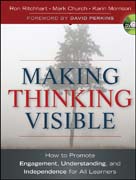
Making thinking visible: how to promote engagement, understanding, and independence for all learners
Ritchhart, Ron
Church, Mark
Morrison, Karin
A proven program for enhancing students' thinking and comprehension abilitiesVisible Thinking is a research-based approach to teaching thinking, begun at Harvard's Project Zero, that develops students' thinking dispositions, while at the same time deepening their understanding of the topics they study. Rather than a set of fixed lessons, Visible Thinking is a varied collection of practices, including thinking routines—small sets of questions or a short sequenceof steps—as well as the documentation of student thinking. Using this processthinking becomes visible as the students' different viewpoints are expressed,documented, discussed and reflected upon. Helps direct student thinking and structure classroom discussion Can be applied with students at all grade levelsand in all content areas Includes easy-to-implement classroom strategies The book also comes with a DVD of video clips featuring Visible Thinking in practice in different classrooms. INDICE: List of Tables and Figures. DVD Contents. Foreword (David Perkins). Preface. Acknowledgments. The Authors. Part One Some Thinking about Thinking. One Unpacking Thinking. Beyond Bloom. Beyond Memorization, Work, and Activity. A Map of Thinking Involved in Understanding. Other Kinds of Thinking. Uncovering Students' Thinking about Thinking. Two Putting Thinking at the Center ofthe Educational Enterprise. How Does Visibility Serve Both Learning and Teaching? How Can We Make the Invisible Visible? Documenting. Part Two Using Thinking Routines to Make Thinking Visible. Three Introduction to Thinking Routines.Three Ways of Looking at Thinking Routines. How Are the Thinking Routines Organized? Four Routines for Introducing and Exploring Ideas. See-Think-Wonder. Zoom In. Think-Puzzle-Explore. Chalk Talk. 321 Bridge. Compass Points. The Explanation Game. Five Routines for Synthesizing and Organizing Ideas. Headlines. Color, Symbol, Image. Generate-Sort-Connect-Elaborate: Concept Maps. Connect-Extend-Challenge. The 4C's. The Micro Lab Protocol. I Used to Think.. , Now I Think.. Six Routines for Digging Deeper into Ideas. What Makes You Say That? Circle of Viewpoints. Step Inside. Red Light, Yellow Light. Claim-Support-Question. Tug-of-War. Sentence-Phrase-Word. Part Three Bringing the Power of VisibleThinking to Life. Seven Creating a Place Where Thinking Is Valued, Visible, and Actively Promoted. Making Room for Reflection. Making Time for Our Own Learning. The Making of an Elaborated Conversation. The Forces That Shape Culture.Eight Notes from the Field. The Challenges of Making Thinking Visible in a Mathematics Class and Beyond: The Case of Mark Church. Content + Routines + Students = A Culture of Thinking: The Case of Sharonne Blum. Stages of Developmentin the Use of Thinking Routines. Common Pitfalls and Struggles. In Conclusion. References.
- ISBN: 978-0-470-91551-6
- Editorial: John Wiley & Sons
- Encuadernacion: Rústica
- Páginas: 320
- Fecha Publicación: 07/04/2011
- Nº Volúmenes: 1
- Idioma: Inglés
